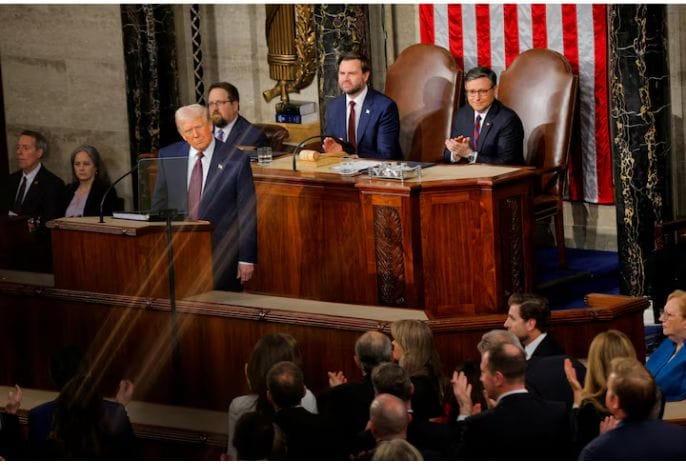On March 4, 2025, President Donald Trump addressed a joint session of Congress at the U.S. Capitol in Washington, DC. His speech, which lasted nearly one hour and forty minutes, was a mix of policy updates, political attacks, and campaign-style rhetoric. Trump’s address to Congress highlighted his administration’s rapid changes, focusing on tariffs, government efficiency, and foreign policy. While his supporters cheered, his critics remained skeptical.
A Highly Partisan Address
From the start, it was clear that Trump’s address to Congress would be unlike most presidential speeches. He began by celebrating his election victory and quickly shifted to criticizing Democrats. He accused them of blocking his efforts and refusing to acknowledge his achievements.
During the speech, tension in the chamber was evident. Some Democratic lawmakers protested, with Rep. Al Green being escorted out after repeatedly interrupting. Others silently held signs or walked out in defiance. Trump did not attempt to ease the divide. Instead, he called out the “radical left” and used controversial nicknames for his political opponents.
Always in Campaign Mode
Throughout his speech, Trump focused on issues that resonate strongly with his base. He vowed to eliminate what he called “wokeness” from schools and the military, emphasizing his administration’s stance on diversity programs and transgender rights.
“We’re getting rid of wokeness. It’s gone from schools, the military, and soon from society,” he declared. To illustrate his points, he introduced guests in the First Lady’s box, including parents of crime victims and female athletes affected by transgender policies. These moments reinforced his “common sense revolution” theme, though they did little to bridge partisan divisions.
Rapid Changes in Government

Trump’s second term has been marked by swift and sweeping executive actions. His administration, now more experienced, has aggressively pushed reforms. However, many Americans remain uncertain about the impact of these changes. Trump’s address to Congress was his opportunity to explain his vision.
One of the most discussed figures in the audience was Elon Musk, who leads the Department of Government Efficiency. Trump praised Musk for cutting wasteful programs, though critics argue that the cuts have affected essential services. Holding up a list, Trump claimed many programs were unnecessary, though fact-checkers later disputed some of his statements.
Tariffs and Economic Strategy
Trump has long supported tariffs, and his latest measures against Mexico, Canada, and China sparked immediate market reactions. Just hours before his speech, stock markets dipped due to concerns over the economic impact. Despite this, Trump stood firm on his approach.
“Whatever they tax us, we tax them back. That’s fair trade,” he declared. He promised that tariffs would bring “trillions of dollars” into the economy and create jobs. While some Republicans expressed concerns, Trump dismissed worries about potential economic disruptions.
“Tariffs make America rich again. Yes, there might be some bumps, but we’ll be fine,” he assured.
Addressing the Ukraine Conflict
Although his speech primarily focused on domestic issues, Trump could not ignore the ongoing war in Ukraine. He spoke of working to end the conflict and referenced a letter from Ukrainian President Volodymyr Zelensky. While he did not offer new strategies, he reiterated his belief that the U.S. has spent too much on the war.
Trump originally planned to announce a new rare earth minerals deal with Ukraine, but a recent dispute with Zelensky disrupted those plans. Instead, he used the speech to express frustration over U.S. financial aid to the country.
Biden Takes the Blame
A major theme of Trump’s address to Congress was his criticism of former President Joe Biden. He blamed Biden for inflation, foreign policy failures, and economic struggles.
“As you all know, the last administration left us with a disaster—high prices, weak leadership, and failed policies,” Trump stated. He argued that many of America’s current issues could have been avoided with different leadership.
He also criticized Biden’s approach to border security, claiming that “a new president” was all that was needed to fix immigration problems. While it’s common for new presidents to highlight the challenges they inherit, Trump’s continued focus on Biden raised questions about how long he could use this strategy before voters expect results.
Democratic Response
Following Trump’s address to Congress, Democratic Sen. Elissa Slotkin delivered a rebuttal. She accused Trump and Musk of pushing reckless government reforms and creating chaos. Slotkin kept her speech concise, focusing on the potential consequences of Trump’s policies.
The sharp contrast between Trump’s speech and the Democratic response underscored the deep political divisions in the country. While Trump’s supporters praised his boldness, his critics warned of the risks of his policies.
Final Thoughts
Trump’s address to Congress was a reflection of his leadership style—direct, controversial, and unapologetic. He celebrated his accomplishments, attacked his opponents, and reaffirmed his commitment to policies that energize his base.
However, his speech did little to unite the country. Instead, it reinforced the deep political divide that continues to shape American politics. As his administration moves forward, the effectiveness of his policies and his ability to deliver results will determine whether his vision for America is embraced by more than just his core supporters.

